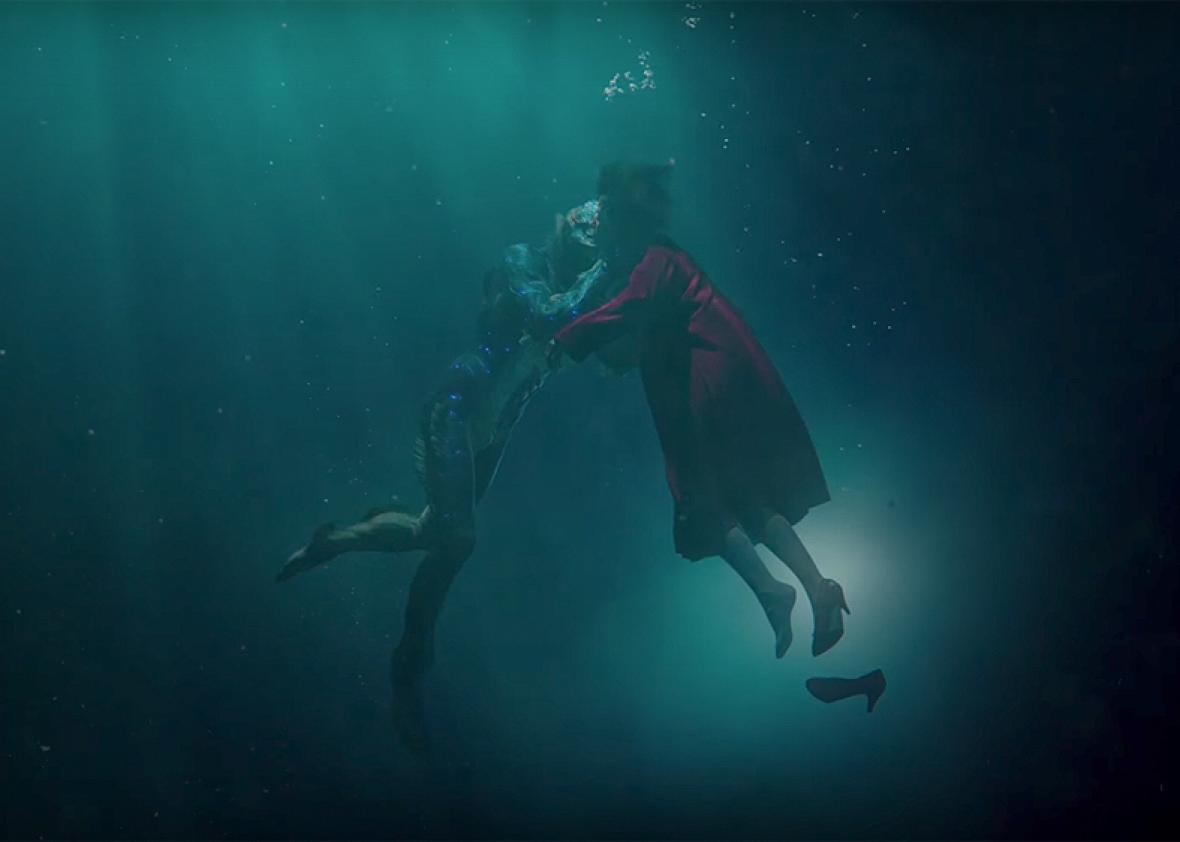The 90th Academy Awards saw The Shape of Water leading Oscar nominees with thirteen nods. Most prestigious was the film’s win for Best Picture, joining fellow nominee Get Out as two of only seven thriller-horror films* to have ever received a Best Picture nomination since the award debuted in 1929 – significant triumphs for the oft-forgotten genre. But inspired by his childhood memories of Creature from the Black Lagoon, director Guillermo del Toro’s trademark appetite for blood and body horror (think stinging cheek wounds) runs just as thick as the underwater romancing between our two unlikely lovers: a night-shift cleaner and an Amazonian river god.
Described as an “adult fairy tale,” the film opens with an exploration of an apartment interior, submerged in the lush and luminous greens of seawater – a tone and colour palette preserved in the rich set and costume designs amidst occasional shocks of red. A “princess without voice” drifts serenely above a floating sofa bed, dreaming; treading del Toro’s precarious line between fantasy and reality. Our princess soon wakes as Elisa (played by Sally Hawkins), an orphan who as an infant was found by a river with gill-like scars that have left her physically mute. She lives on her own, though opposite to neighbour and confidante Giles (Richard Jenkins), and works as a cleaner at a secret government facility alongside friend and interpreter, Zelda (Octavia Spencer). The year is 1962, and the Cold War’s Space Race preoccupies the mind of the facility’s brutal head, Colonel Strickland (Michael Shannon), who has captured and delivered an amphibious creature from South America (Doug Jones) capable of language – and of love – to be harvested for research. The sublime narrative is poetically bookended with Elisa once again unconscious and underwater, though this time swathed in red that echoes moments throughout the film marked by longing: high-heeled pumps, an empty cinema, her favourite vinyl records. We hope she lives happily ever after.
The Shape of Water is, all in all, a breathtaking piece of cinematic voice. The vision of production designer Paul Austerberry and cinematographer Dan Laustsen seamlessly blends the watercolours of the whimsical with the shadows preceding the violence. The score’s main theme, a simple tune of composer Alexandre Desplat’s own whistle and a tango accordion, is reminiscent of the soft ebb and flow of a warm undercurrent. The screenplay by Vanessa Taylor and del Toro himself is heavy with metaphor and thematic weight, containing obvious but nevertheless important political commentaries à la Pan’s Labyrinth, with references to privilege and prejudice, observing ableism, misogyny, homophobia, and racism. Particularly keen audience members will enjoy the film’s (boiled) Easter Eggs: Elisa’s Baltimore apartment is directly above ‘The Orpheum’ cinema theatre, named after the Greek legend of Orpheus; one of Giles’ cats, Pandora, loses its head due to curiosity; enamoured with polished shoes and tap dancing, Elisa is a mermaid soul trapped with human legs.
This genre-blurring fantasy world de Toro has brought to life is too stunning to miss. Even as the story plummets in and out of torture and tragedy, the empathy and passion between Elisa and her Amphibian Man relentlessly holds our breath. Succumb to the smiles and heartache and dive into the wonder that is The Shape of Water.
* The Exorcist (1973), Jaws (1975), The Silence of the Lambs (1990), The Sixth Sense (1999), and Black Swan (2010)
We acknowledge the Ngunnawal and Ngambri people, who are the Traditional Custodians of the land on which Woroni, Woroni Radio and Woroni TV are created, edited, published, printed and distributed. We pay our respects to Elders past and present. We acknowledge that the name Woroni was taken from the Wadi Wadi Nation without permission, and we are striving to do better for future reconciliation.
